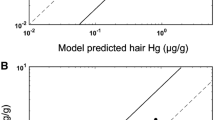Abstract
Results of long-term toxicity studies of methylmercury (MeHg) in monkeys have been reported. The aim of this study was to estimate the threshold body burden, blood level and threshold daily intake (TDI) of MeHg for monkey and human. The concepts of this study stood on that body burden of MeHg would follow the accumulation theory, and that the more intake of MeHg, the earlier the neurotoxicity appeared, vice versa. The threshold blood level (TBL) of monkey was estimated to be 0.71 as Hg mg/L and the body burden was estimated to be 4.83 as Hg mg/kg. The TDI was estimated to be 0.025 as Hg mg/kg day. In human, the TBL was estimated with compensation by elimination constants of human and monkey. The blood threshold limit and TDI of human were estimated to be 0.33 as Hg mg/L and 0.0046 as Hg mg/kg day, respectively. The estimated body burden was 0.46 as Hg mg/kg.





Similar content being viewed by others
References
Aberg B, Ekman L, Falk R, Greitz U, Persson G, Snihs JO (1969) Metabolism of methylmercury (203Hg) compounds in man. Arch Environ Heath 19:478–484
Bakir F, Damluji SF, Amin-Zaki L, Murtadha M, Khalidi A, Al-Rawi NY, Tikriti S, Dhahir HI, Clakson TW, Smith JC, Doherty RA (1973) Methylmercury poisoning in Iraq. Science 181:230–241
Bakir F, Rustam H, Tikriti S, Al-Damluji SF, Shihristani H (1980) Clinical and epidemiological aspects of methylmercury poisoning. Postgrad Med J 56:1–10
Berlin M, Carlson J, Norseth T (1975) Dose-dependence of methylmercury metabolism a study of distribution: biotransformation and excretion in Squirrel monkey. Arch Environ Health 30:307–313
Debes F, Budtz-JØrgensen E, Weihe P, White RF, Grandjean P (2006) Impact of prenatal methylmercury exposure on neurobehavioral function at age 14 years. Neurotoxicol Teratol 28(3):363–375
Falk R, Snihs JO, Ekman L, Greitz U, Aberg B (1970) Whole-body measurements on the distribution of mercury-203 in humans after oral intake of methylradiomercury nitrate. Acta Radiol Ther Phys Biol 9(1):55–72
Huff RL, Feller DD (1956) Relation of circulating red cell volume to body density and obesity. J Clin Invest 35:1–10
Ikeda Y, Tobe M, Kobayashi K, Suzuki S, Kawasaki Y, Yonemaru H (1973) Long-term toxicity study of methylmercury chloride in monkeys (first report). Toxicology 1:361–375
Kamis AB, Noor NM (1981) Blood volume in Macaca fascicularis. Primates 22(2):281–282
Kawasaki Y, Ikeda Y, Yamamoto T, Ikeda K (1986) Long-term toxicity study of methylmercury chloride in monkeys. J Food Hyg Soc Jpn 27:528–552
Rice DC, Krewski D, Collins BT, Willes RF (1989) Pharmacokinetics of methylmercury in the blood of monkeys (Macaca fascicularis). Fundam Appl Toxicol 12(1):23–33
Sabelaish S, Hilmi G (1976) Conference on intoxication due to alkylmercury-treated seed Baghdad, Iraq, 9–13 September. Bull WHO 53(Suppl):83–86
Sherlock J, Hislop J, Newton D, Topping G, Whittle K (1984) Elevation of mercury in human blood from controlled chronic ingestion of methylmercury in fish. Hum Toxicol 3(2):117–131
Swartout J, Rice G (2000) Uncertainty analysis of the estimated ingestion rates used to derive the methylmercury reference dose. Drug Chem Toxicol 23(1):293–306
Acknowledgment
We thank the late honorary professor Shoji Kitamura, Department of Public Health, Kobe University School of medicine who this study arrives, and had valuable advice.
Author information
Authors and Affiliations
Corresponding author
Rights and permissions
About this article
Cite this article
Yamamoto, R., Shima, M. Estimation of human maximum tolerable intake for methylmercury based on two recent studies in monkeys. Arch Toxicol 83, 1043–1048 (2009). https://doi.org/10.1007/s00204-009-0454-7
Received:
Accepted:
Published:
Issue Date:
DOI: https://doi.org/10.1007/s00204-009-0454-7




